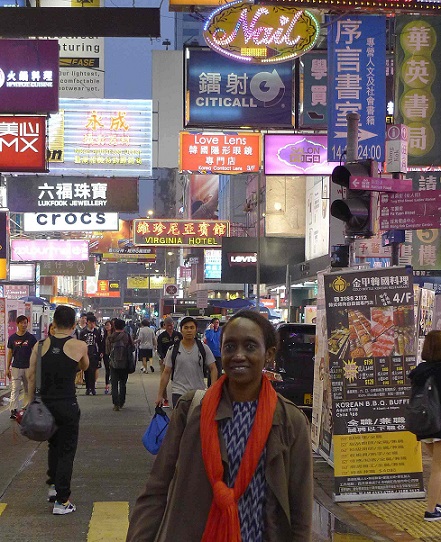藝評
無視生命 (Ignoring Life)
約翰百德 (John BATTEN)
at 9:16am on 16th May 2016

圖片說明 Caption:
N’Goné Fall outside upstairs bookshop HK Reader in Mong Kong, April 2016
(Please scroll down for English version)
我在閱讀葡萄牙作家費爾南多.佩索阿(Fernando Pessoa)的《惶然錄》(The Book of Disquiet)。書首幾句是這樣的:「在我出生的那個時代,大多數年輕人不再信上帝,和他們 的前輩信仰上帝一樣,同樣出於未知的原因。」,是起筆的好例子。
佩索阿生於1888年,筆下所指的年代是就在這年以後。如果你把「上帝」一詞換成相應的一般信念,例如是「民主」、「資本主義」、「共產主義」,或「希望」等,這句說話可能只是自明之理。但是末句「……同樣出於未知的原因」,幾乎可以令這句成為可信的真理,因為大部份信仰和意見,其實都未有完全被明白。小孩發問時會用上「為什麼」,通常表示他們需要答案。我們希望世界可以被明白。但隨著年齡漸長,知道事情「為什麼」,又或「為什麼」事情會發生,變得越來越不迫切。偏見與意見很多時都是一種默認,一種不思考、一種「知道」。
然而,《惶然錄》的開首句只是本書編輯和英語翻譯理查德.澤尼斯(Richard Zenith)的建議。佩索阿於1935年離世,當時書籍還未出版。這是一個長期計劃,作者在二十年內不斷回訪,直至他臨終以前。佩索阿為《惶然錄》一書,把一疊隨意以打字機打出或手寫的筆記,還有一個放滿可供出版文章的信封,好好放在一大個行李箱中。這些文字於1998年才以葡萄牙文首次彙集面世。這本書以佩索阿的家鄉里斯本市為主題,探討生命、他的內心世界和性格。佩索阿屬於葡萄牙首批現代主義詩人,他生命中大部份時間都從事英語和葡語的各式商業翻譯工作。在很多方面,他的生命頗為平庸,而這點也在書中反映。佩索阿博覽葡萄牙語、英語與法語群書,他在書中曾經提到:「文學是無視生命最適意的方法。」
…
我在上環地鐵站與N’Goné Fall會面,她是塞內加爾人,是一位居於巴黎的策展人和作家,此前曾擔任建築師。她獲北角的Parasite藝術空間贊助在香港作短期探訪,她很想認識香港的城市環境。我們在討論藝術與香港的城市規劃之間來到石硤尾,這是最完美的起點,因為這裡有各種公共房屋,最古老的可追溯至1960年代。這些較舊的建築物正被逐步拆卸,由新型的公共房屋大樓取代。新大樓沒有像舊式低樓層建築物一樣提供共用空間和遊樂場,少了一份親切與鄰里人情味。我們在附近散步,然後參觀了賽馬會創意藝術中心,它由工業大廈改建而成。雖然大樓的規劃與翻新都是為藝術工作室而設,但現時大部份的創意,只集中於開辦兒童畫班。
我們走到附近的美荷樓,香港第一幢創新的「H」型公屋,於1950年代建成,是現在僅存的惟一一幢同類大樓,用途已變成青年旅舍,由香港青年旅舍協會經營。很可惜,新增的圍封露台、鏡面玻璃,還有了無生氣的新油漆,令它原有的歷史再難辨認。它現在看去就像新建大廈一樣,在體積與高度上與一所小型學校相似。翻新,又或政府慣用的「活化」,太多時候會破壞歷史建築所保留的重重歷史。我們看到的只是千篇一律的舊建築物清潔版本。
但是,美荷樓內設的小型博物館卻相當不錯。裡面設有極佳的展示,講述了關於1953年石硤尾大火的事跡和香港公共房屋的歷史。此外,還有不少關於上世紀五、六十年代生活,喚起人們回憶的展品,題材包括人們的工作、上學情況,還有日常生活及知名人士的故事,好像導演吳宇森,就是在區內長大。我給N’Goné展示了從前往來啟德機場的航班,在九龍上空的飛行路徑,告訴她這是九龍大部份大廈直至近年以前,都沒有建成高樓大廈的原因。我們討論了士紳化的問題,再走到深水埗實地觀察市區重建局的社區破壞行為,和沒頭沒腦的建築。我們在街市間漫步,再親身見證環球貿易發生:非洲商人向香港商人購買二手電視,送回非洲出售。最後,我們探訪了喧鬧的旺角,我就是在樓上書店序言書室買下了佩索阿這本書。
…
幾天後,N’Goné辦了一場小講座,談及塞內加爾、非洲藝術,以及她欣賞的亞洲與及世界各地的其他藝術家。
…
然後傳奇的剛果音樂家及時裝教父Papa Wemba於2016年4月24日與世長辭。
世上有偉大的文學,沒有人在無視生命。
原文刊於《明報周刊》,2016年5月7日。
(Translated by Aulina Chan)
'Ignoring Life'
John Batten
I am reading the Portuguese writer Fernando Pessoa’s 'The Book of Disquiet'. Its ‘opening’ lines are one of the great starts to a book: “I was born in a time when the majority of young people had lost faith in God, for the same reason their elders had had it – without knowing why.”
He is referring to the years after his own birth in 1888, but if you replace the word ‘God’ and insert an equivalent, a general belief – such as, ‘democracy’, ‘capitalism’, ‘communism’, or ‘hope’, etc - it could simply be a truism. But, the rejoinder “… - without knowing why” makes it an almost believable truth as most beliefs and opinions are not fully understood. The question “why” constantly asked by children is also usually a demand for an answer. We wish the world to be understandable. As we get older, knowing “why” about something or something happening becomes less urgent. Prejudices and opinions are often a default, unthinking, ‘knowing.’
However, the opening lines of 'The Book of Disquiet' are only a suggestion by the book’s editor and English translator, Richard Zenith. Pessoa died in 1935 before the book’s publication; it was a long-term project that the writer visited on-and-off for twenty years until just before his death. Pessoa had put a stack of random typed and hand-written jottings and an envelope of potential passages for 'The Book of Disquiet' into a large trunk. These were only compiled into a first Portuguese edition in 1998. It is a book located in Pessoa’s home city of Lisbon, exploring life, his inner thoughts and personality. Pessoa was one of the first of Portugal’s modernist poets, but worked most of his life as an English and Portuguese translator for a variety of commercial businesses. In many ways, his life was banal, and this is much reflected in the book. Well-read in Portuguese, English and French, Pessoa at one point says in the book, “Literature is the most agreeable way of ignoring life.”
…
I met N’Goné Fall, a Senegalese art curator, writer and former architect living in Paris at the Sheung Wan MTR station. On a short visit to Hong Kong courtesy of Parasite art space in North Point, she wanted to know about Hong Kong’s urban environment. While chatting about art and Hong Kong urban planning, we travelled to Shek Kip Mei, a perfect place to start as it has a range of public housing dating from the 1960s. These older buildings are slowly being demolished and replaced by huge blocks of newer public housing lacking the intimacy and camaraderie that the older low-rise buildings with their communal and playground areas provide. We walked around and then visited JCCAC – housed in a converted industrial building. Despite its planning and renovation as artists’ studios, much of the building’s creativity is merely focused on children’s painting classes.
We walk to nearby Mei Ho House, one of Hong Kong’s first, innovative ‘H’ styled public housing blocks of the 1950s and the only one still preserved. It has been converted into a youth hostel run by the YHA – unfortunately, with newly enclosed balconies, mirrored glass, and an insipid repaint the layers and patina of its proud history are hardly acknowledged. It now looks like a new building, similar in size and height as a small school. Renovations, or as government refer to it, ‘revitalisation’, too often destroys the layers of history of the built heritage that has been preserved. We see a clean version of the built past as a homogenous life.
But, the small museum inside Mei Ho House is good. There are excellent displays about the 1953 Shek Kip Mei fire and the history of public housing in Hong Kong. There are evocative depictions of life in the 1950s and 1960s, with photographs of people’s work, schooling and daily life and stories from personalities, such as film director John Woo, who grew up in the area. I showed N’Goné the airline flight path over Kowloon towards the former Kai Tak Airport that kept, until recently, most of Kowloon’s buildings low-rise. We discussed gentrification and then walked to Sham Shui Po to see the destruction and mindless architecture of the Urban Renewal Authority. We strolled through the street markets and looked at global trade in action: African traders buying second-hand televisions from Hong Kong traders to sell in Africa. Finally, we then visited vibrant Mong Kok and I bought Pessoa’s book in the upstairs bookshop HK Reader.
…
A few days later, N’Goné gave a short talk about Senegal, African art and other artists from Asia and the world that she likes.
…
Then the legendary Congolese musician and fashion icon, Papa Wemba, died on 24 April 2016.
There is great literature and there’s no ignoring life.
This article was originally published in Ming Pao Weekly, 7 May 2016.
|
|
|
|
|
|
